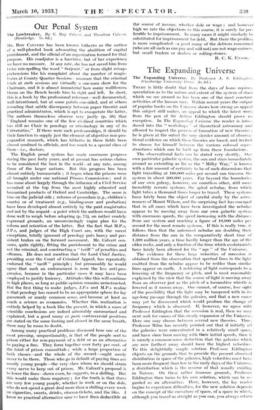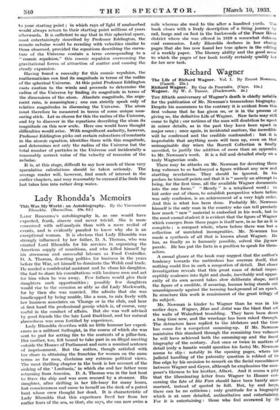The Expanding Universe
The Expanding Universe. By Professor A. S. EddiligtA)n. (Cambridge University l'ress. 3s. 6d.) THERE is little doubt that from the days of hon►o sapirny, speculation as to the nature and extent of the system of stars which we see around us has been one of the most constant activities of the human race. Within recent years the output of popular books on the Universe shows how strong an appeal this subject still makes, an appeal to which the latest work from the pen of Sir Arthur Eddington should prove no exception. In The Em'pandieg Universe the reader is intro- duced into the " workshops " of theoretical astronomy and allowed to inspect the process of formation of new theories ; he is given at the outset the very slender amount of observa- tional evidence on which these theories are based, and invited to choose for himself between the various colossal super- structures which can be built up from these foundations. •
The observational facts can be stated very shortly. Our own particular galactic system, the sun and stars immediately around us extending as far as the " Milky Way," is known with a fair amount of certainty to be of such dimensions that light travelling at 186,000 n►iles per second can traverse the system in about 300,000 years. Far beyond the boundaries of our own galaxy, however, are countless other, still more incredibly remote systems, the spiral nebulae, from wlmicl► light takes a thousand times longer to travel. These systems have lately been the object of careful study by the astro- nomers of Mount Wilson, and the surprising fact has emerged that in all eases which have been investigated time nebulae appear to be moving away from our own galactic system with enormous speeds, the speed increasing with the distance from our system and reaching a figure of 10,000 miles per second for the most remote systems. If this is really true, it follows then that the outermost nebulae are doubling their distance from the sun in the comparatively short time of 1,300 million years, a time hardly longer than the age of the older rocks, and only a fraction of the time which evolutionists have lately been allowed for the " age " of the Universe.
The evidence for these large velocities of recession is obtained from the observation that spectral lines in the light emitted from the nebulae appear to be redder than similar lines appear on earth. A reddening of light corresponds to a lowering of the frequency or pitch, and is most reasonably explained by the view that the source of light is moving away from an observer just as the pitch of a locomotive whistle is lowered as it moves away. One cannot, of course, lose sight of the possibility that the light may be tampered with in its age-long passage through the galaxies, and that a new Cause may yet be discovered which would produce the change of frequency which► is observed. If, however, we agree with► Professor Eddington that the recession is real, then we may next seek for causes of this steady expansion of the UlaiNZerse. Here one may choose between several new theories. Thus, Professor Milne has recently pointed out that if initially all the galaxies were concentrated in a relatively small space, and have since been moving with their initial speeds, then it is merely a common-sense deduction that the galaxies which arc now farthest away should have the highest velocities. To this delightfully simple solution Professor Eddington objects on the grounds that to provide the present observed distribution in space of time galaxies, high velocities must have been more frequent than low in the early days of the Universe, a distribution which is the reverse of that usually existing in Nature. On these rather insecure grounds, Professor Eddington then turns to his own solution, which can be re- garded as an alternative. Ikre, however, the lay reader begins to experience difficulties, for the new solution depends on the concept of the curvature of space, of a space in which, although you travel as straight as you can, you always return to your starting point ; in which rays of light if unabsorbed would always return to their starting point millions of years afterwards. It is sufficient to say that in this spherical space, most entertainingly described by Professor Eddington, the remote nebulae would be receding with velocities similar to those observed, provided the equations describing-the curva- ture of the Universe contain a term corresponding to a " cosmic repulsion," this cosmic repulsion overcoming the gravitational forces of attraction of matter and causing the steady expansion: Having found a necessity for this cosmic repulsion, the mathematician can find its magnitude in terms of the radius of the spherical Universe. At this point Professor Eddington casts caution to the winds and proceeds to determine the radius of the Universe by finding its magnitude in terms of the dimensions of the atom. Absolute magnitude, the argu- ment runs, is meaningless-; one can strictly speak only of relative magnitudes in discussing the Universe. The atom must therefore be measured in terms of some unique mea- suring stick. Let us choose for this the radius of the Universe, and try to discover in the equations describing the atom its magnitude on this new scale. Here one would have thought difficulties would arise. With magnificent audacity, however, Professor Eddington picks out certain calorations of constants in the atomic equation, identifies them with this magnitude, and determines not only the radius of the Universe but the total number of particles in the Universe and incidentally a reasonably correct value of the velocity of recession of the nebulae.
It is, at this stage, difficult to say how much of these very speculative calculations should be taken seriously. The average reader will, however, fmd much of interest in the earlier chapters, and may reasonably be excused if he finds the last takes him into rather deep water.







































 Previous page
Previous page